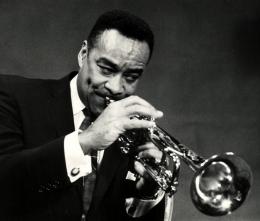Died: 1991 Instrument: Trumpet Buck Clayton first rose to national fame as the lead soloist with the first great Count Basie band that roared out of Kansas City in late fall, 1936. Ironically, Clayton’s bell-like, understated sound is often associated with Kansas City’s hard swinging style. However, he spent very little time in Kansas City. Clayton was already a successful band leader with a diverse career that took him from Los Angeles to Shanghai by the time he arrived in the Reno Club on 12th Street. Clayton was born in Parsons, Kansas. He grew up in a musical household. Clayton learned the basics of music from his father, a minister. Clayton began playing the trumpet when he was a teenager and performed with the church band that featured his mother on the organ. Clayton first heard jazz’s clarion call during a visit to Parsons by the George E. Lee Band. Clayton moved to California with his muse after high school. This is where he started his professional career. Clayton joined Charlie Echols’ 14-piece band in Los Angeles. They played taxi dances and ballrooms. Clayton and the other members of the band soon left Echols in order to work with Earl Dancer, a Broadway producer, and make movies. Clayton assumed the leadership of the group after Dancer, a frequent gambler, vanished with the payroll. Clayton, just 23 years old led his band to China. The Clayton band was one of the first to perform the Orient in Shanghai, China’s Canidrome Ballroom. Madame Chiang Kai- Shek, along with other celebrities, flocked to Canidrome every night to dance to the hot jazz and classical music of the band, who were dressed in tails. Clayton spent the next two-years at the Canidrome with a brief jaunt to Japan. Clayton lost his job at the Canidrome after a fight with a former Marine. Clayton and the rest of the band fled Shanghai in search of steady work. Clayton returned to Los Angeles and reformed the band. He also played at Sebastian’s Cotton Club, Club Araby and other venues. Clayton moved to New York in 1936 to join Willie Bryant and his band at the Cotton Club. Clayton made a stop in Kansas City on his way to New York. He joined the Reno Club’s Basie Band, replacing Hot Lips Page, as the star soloist. Clayton’s solo talent, arrangements and compositions helped to boost the popularity of the Basie Band. Clayton was with the Basie group until he was drafted, in 1943. Clayton was discharged in 1946 and led a small group at Cafe Society. He also toured the country with the Jazz at the Philharmonic. Clayton toured Europe in the 1950s with his own band and worked freelance with Joe Bushkin and Jimmy Rushing. Clayton was both a sideman as well as a leader and recorded many songs for Columbia. He also produced a series jam sessions for John Hammond’s Columbia label. Clayton devoted his time to composing and organizing for other groups after being sidelined by liposuction in 1967. In the 1970s, he returned to playing and toured worldwide with his own band. Clayton began to teach at Hunter College in New York and continued his career as a director, composer, and arranger after his lip failed. Clayton started a band in 1987 to perform his songs. Clayton led his “Swinging Dream Band” until he died in 1991. Source: James Nadal, allaboutjazz
